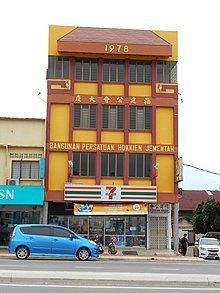This article needs additional citations for verification. (January 2022) |
| Southern Malaysia Hokkien | |
|---|---|
| 南马福建话 Lâm-Má Hok-kiàn-oē (POJ) | |
| Native to | Southern Malaysia |
| Region | Johor and Malacca |
Early forms | |
| Dialects |
|
| Language codes | |
| ISO 639-3 | nan for Southern Min / Min Nan which encompasses a variety of Hokkien dialects including "in Malaysia, most notably in and around Kuching, Muar, Klang".[4] |
| Glottolog | None |
| Linguasphere | 79-AAA-jek |

Southern Malaysian Hokkien (simplified Chinese: 南马福建话; traditional Chinese: 南馬福建話; pinyin: Nán Mǎ Fújiànhuà; Pe̍h-ōe-jī: Lâm-Má Hok-kiàn-oē) is a local variant of the Min Nan Chinese variety spoken in Central and Southern Peninsular Malaysia (Klang, Melaka, Muar, Tangkak, Segamat, Batu Pahat, Pontian and Johor Bahru). Due to geographical proximity, it is heavily influenced by Singaporean Hokkien.
This dialect is based on Quanzhou-accented varieties of Min Nan, including the Eng Choon (Yongchun) dialect.[5][6] It is markedly distinct from Penang Hokkien and Medan Hokkien, which are based on the Zhangzhou dialects.
Similar to the situation in Singapore, the term Hokkien is generally used by the Chinese in South-east Asia to refer to Min Nan Chinese (闽南语). Southern Malaysian Hokkien is based on the Quanzhou dialects with some influence from the Amoy dialect. The dialect also contains loan words from Malay.
- ^ Mei, Tsu-lin (1970), "Tones and prosody in Middle Chinese and the origin of the rising tone", Harvard Journal of Asiatic Studies, 30: 86–110, doi:10.2307/2718766, JSTOR 2718766
- ^ Pulleyblank, Edwin G. (1984), Middle Chinese: A study in Historical Phonology, Vancouver: University of British Columbia Press, p. 3, ISBN 978-0-7748-0192-8
- ^ Hammarström, Harald; Forkel, Robert; Haspelmath, Martin; Bank, Sebastian (2023-07-10). "Glottolog 4.8 - Min". Glottolog. Leipzig: Max Planck Institute for Evolutionary Anthropology. doi:10.5281/zenodo.7398962. Archived from the original on 2023-10-13. Retrieved 2023-10-13.
- ^ "Reclassifying ISO 639-3 [nan]" (PDF). GitHub. 31 August 2021. Retrieved 28 July 2022.
- ^ Chang & Hsieh 2012, p. 38.
- ^ Huang, Chang & Hsieh 2011, p. 914.
Cite error: There are <ref group=lower-alpha> tags or {{efn}} templates on this page, but the references will not show without a {{reflist|group=lower-alpha}} template or {{notelist}} template (see the help page).
